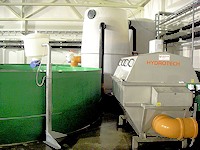The production and management
Production
 The
origin of the sturgeon in this farm is from several stocks in France
and Italy, initially brought both as eggs and fingerlings. Nowadays
nothing is brought into the farm any more to avoid risks of disease
introduction. The fingerling production is now based on own
production and the farm produces 15.000 to 30.000 fingerlings
annually. The farm aims to produce 4 to 6 tons of caviar per year
and about 50 to 100 tons of sturgeon meat. The farm produces tens of
tons of males which are culled at the size of 2 kg when separated
from the females. Their meat goes for further processing to another
company (Savokala) which is situated right next door; this company
is specialized to process all kinds of lake fish, also from the
fisheries. The caviar is processed and packed on the site (Figure
6). Caviar is the main product of the farm, and sturgeon meat is
side product. The amount of caviar produced by one female varies
between 10 and 16 % per kg.
The
origin of the sturgeon in this farm is from several stocks in France
and Italy, initially brought both as eggs and fingerlings. Nowadays
nothing is brought into the farm any more to avoid risks of disease
introduction. The fingerling production is now based on own
production and the farm produces 15.000 to 30.000 fingerlings
annually. The farm aims to produce 4 to 6 tons of caviar per year
and about 50 to 100 tons of sturgeon meat. The farm produces tens of
tons of males which are culled at the size of 2 kg when separated
from the females. Their meat goes for further processing to another
company (Savokala) which is situated right next door; this company
is specialized to process all kinds of lake fish, also from the
fisheries. The caviar is processed and packed on the site (Figure
6). Caviar is the main product of the farm, and sturgeon meat is
side product. The amount of caviar produced by one female varies
between 10 and 16 % per kg.
Mortality
Mortality from the egg to 1 g size varies between 5 and 50 %. After the start-feeding stage mortality is low, and during the first year mortality is typically 5-10%, and after first year there is almost no mortality. If there is mortality, the reason is a sudden change in water quality. There are practically no or only very little disease problems. However, the juveniles are sometimes infected with Flavobacterium.
Rearing densities depend on fish size and water temperature. Maximum densities for fishes less than 500 g is 30 kg/m3 and for large fish 65 kg/m3.
Annual production cycle
The strength of this farm when compared to many other caviar producers is that they produce caviar on weekly basis throughout the year except during July-August when temperature is too high. The continuous production is possible due to possibility to regulate water temperature and photoperiod according to the maturational needs. Therefore they do not need to use any other conservatives than salt (3%) in the final product. The shelf life is 4 months when kept at -3 … +3 °C.
Before slaughtering the fish are kept in the so called fasting tanks from 2 weeks up to 2 months depending on the temperature (Figure 7). This is a necessary step to avoid any off-flavors in the marketed product (Figure 8). The fish are killed with a blow on the head and placed in ice slurry. The fish for producing caviar weigh at this point 5 to 15 kg and they are 4 to 8 years old.
Separation males and females
The important working operations in this farm are separation of males using ultrasound, transfer of the fish to different conditions depending whether they are on grow-out or caviar ripening stage, fasting the fish in the separate fasting tanks before slaughtering, stripping the eggs for production of fingerlings, and start feeding of the fingerlings. The final maturation of males and females before stripping (to produce fingerlings) is induced with an injection of GnRH analogue. The feeds are special sturgeon feeds and they are imported from Denmark, Holland and France. Maximum pellet size is 10 mm.
Employment
In total the company employs 10 persons, four of whom are directly working with fish husbandry.